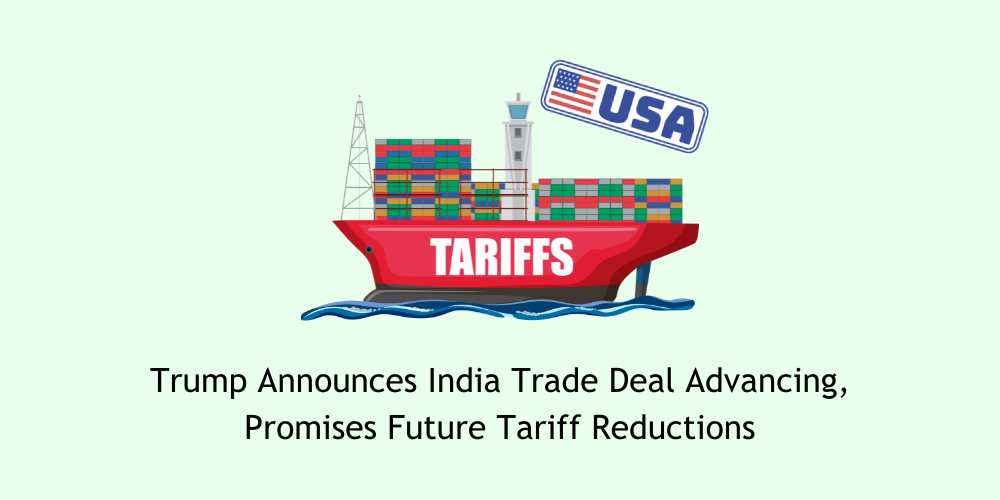Trump Announces India Trade Deal Advancing, Promises Future Tariff Reductions
Introduction
The long-awaited India–US trade pact appears to be moving closer to reality, with US President Donald Trump confirming that both sides are “pretty close” to finalising a new agreement. His latest remarks, made during a swearing-in ceremony at the Oval Office, have revived hopes of tariff relief and improved trade flows between the two countries. With bilateral commerce under pressure in recent months, the prospect of a breakthrough comes at a crucial moment for Indian exporters, market participants, and policy watchers.
Latest Developments in the US–India Trade Deal
Trump’s recent comments have set the tone for renewed optimism around the proposed Bilateral Trade Agreement (BTA). Speaking at the swearing-in of Sergio Gor as the new US Ambassador to India, Trump said the negotiations were progressing well and that both countries were close to finalising a “fair trade deal.”
He added that the earlier agreements were “unfair” and that a reset was underway. Turning to Treasury Secretary Scott Bessent, who was present during the ceremony, Trump said the deal under discussion would be beneficial for both sides.
The more significant takeaway came when Trump hinted at tariff reductions “at some point.” The US had earlier imposed steep duties of up to 50% on Indian goods, including a 25% levy linked to India’s purchase of Russian oil. Trump acknowledged that Indian imports of Russian oil had declined sharply and suggested that tariffs could be reviewed and reduced accordingly.
Indian officials have also provided encouraging signals. Commerce Minister Piyush Goyal said that while discussions were progressing, several “serious and sensitive issues” still needed resolution. Negotiators from both sides have already completed five rounds of talks, with the next milestone targeted for late 2025.
Why the Trade Breakthrough Matters for India Right Now
The anticipated deal comes at a time when India–US trade dynamics have been under strain. The US remains India’s largest trading partner, with flows touching $131.84 billion in FY25. However, India’s exports to the US declined by nearly 12% in September, partly due to higher tariffs and weaker global demand.
With tariff cuts now back on the table, exporters in sectors like textiles, engineering goods, pharmaceuticals, and leather may gain some near-term relief. Lower duties would also ease cost pressures on Indian companies that rely on US inputs for manufacturing and technology-driven production.
From a geopolitical standpoint, the trade deal signals a recalibration of economic ties. A reset with Washington could help India secure greater market access and strengthen supply-chain linkages at a time when global trade alignments are shifting rapidly.
Potential Impact on Indian Markets and Key Export Sectors
Indian equity markets are likely to monitor the India–US trade deal closely, with tariff reductions or phased implementation potentially boosting sentiment in export-driven sectors. Textiles and apparel could see higher order inflows and improved profitability, while pharmaceuticals may benefit from smoother trade and reduced regulatory bottlenecks. IT and services stand to gain from strengthened bilateral ties, supporting outsourcing contracts and workforce mobility. Metals and engineering goods may regain competitiveness as export costs decline. Currency markets could also react, with a stable USD-INR helping ease imported inflation pressures.
Key Indicators Investors Should Track in the Coming Weeks
With negotiations entering a crucial stage, investors should keep an eye on:
• Official statements from the US and Indian commerce departments
• Announcements from the sixth round of negotiations
• Tariff rollback timelines or any interim relief measures
• Impact on export data in the coming months
• Sector-wise guidance from companies with high US exposure
Any clarity on tariff timelines could drive strong near-term reaction in markets, especially among export-heavy mid- and large-cap names.
Conclusion
Trump’s latest remarks mark a significant step forward in the long-running India–US trade negotiations. For India, a more favourable trade regime could ease tariff-related pressures, revive export momentum, and support key sectors that depend heavily on the US market. While several issues still require resolution, the growing signals of progress offer a positive backdrop for investors. As both governments move closer to a structured agreement, markets will watch closely for concrete timelines and policy announcements that could shape trade flows heading into 2025.
Frequently Asked Questions
-
What is the US–India trade deal about?
It is a Bilateral Trade Agreement aimed at improving trade relations, reducing barriers, and boosting exports and imports between the two countries.
-
Why are tariffs important in this deal?
Tariffs affect the cost of Indian goods in the US. Reducing them makes Indian exports more competitive and profitable.
-
How do tariffs impact Indian exporters?
High tariffs raise costs for Indian products in the US, reducing demand; lower tariffs help increase orders and revenue.
-
Which sectors benefit most from a trade deal?
Sectors like textiles, pharmaceuticals, metals, engineering goods, and IT services benefit from improved market access and reduced trade costs.
-
How does the trade deal affect Indian markets?
Positive developments can boost investor sentiment, improve export-driven company earnings, and stabilize the currency.
Disclaimer: This blog is dedicated exclusively for educational purposes. Please note that the securities and investments mentioned here are provided for informative purposes only and should not be construed as recommendations. Kindly ensure thorough research prior to making any investment decisions. Participation in the securities market carries inherent risks, and it's important to carefully review all associated documents before committing to investments. Please be aware that the attainment of investment objectives is not guaranteed. It's important to note that the past performance of securities and instruments does not reliably predict future performance.

